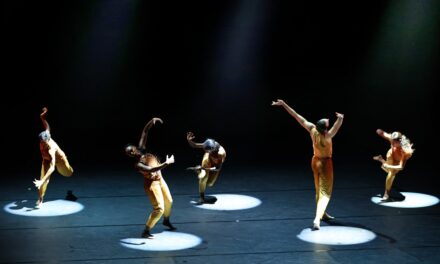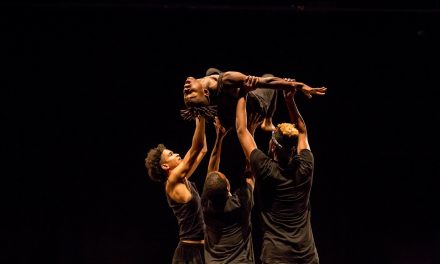On March 31 to April 4, Pacific Northwest Ballet, Artistic Director Peter Boal, generously shared this seasons’ digitally streamed premieres and classics with their dance fans. Presented was Before I Was by choreographer Robyn Mineko Williams and Times are Racing by Justin Peck (PNB Premiere) along with the iconic work Plot Point by Crystal Pite. PNB did seven live performances at Seattle Center’s Marion Oliver McCaw Hall March 18 through 27 to celebrate their 2021-2022 Season. The following is an overview and review of the digital performances.
Plot Point by Crystal Pite (NDT 2010 , PNB Premiere 2017)
Plot Point is the genius work of Crystal Pite, who originally created it for Nederlands Dans Theatre in 2010. Pite, noted for her brilliant exploration of human behavior in movement and her keen musicality, again challenged herself and Pacific Northwest Ballet in 2017 to unleash an imaginative construct of Film Noir in movement, sound, light, and story.
Pite’s journey began with the fierce film score of Bernard Herman’s Psycho, circa 1960. The spirit of the master Noire filmmaker, Alfred Hitchcock, seemed to partner with Pite’s artful exploration of the form. Beginning with Hermann’s score, the construct was instigated in a playwright’s craft of story building. The Plot Points: back story, catalyst, big event, midpoint, crisis, climax and realization served as the skeleton for the intricate segments and signaled appropriate terror, action, violence and suspense almost immediately with the action of one rain-coated person running center stage.
The filmmaker’s tool of storyboard characters, faceless and nameless, appear to lift off the page to become the alter-egos of their live selves. This construct cleverly animates a dynamic juxtaposition between the live and the faceless.
A playwright’s technique of story building brought alive by a filmmaker’s use of shadow and light is beautifully realized by Lighting Designer, Alan Brodie. The sparse hints of minimal sets; a door, a window, a forest, was combined by the expertise of Scenic Designer Jay Gower Taylor. Additionally, the intricate soundscapes; footsteps, windows shattering, voices, punches in the night, are only a taste of Owen Belton’s intricate tongue-in-cheek Foley embellishments indicative of this style of filmmaking.
The creative power of the motivated dancer/actors, the use of body language, attitude, and action signaled that they truly “knew their motivation” and how to tell the story. They evoked nail-biting excitement in the actions of the characters; the blond ingenue, the friends, the thugs, the alter-egos, all were iconic and so well directed and defined that it made this truly entertaining, fascinating and outstanding theatre. Ms. Pite revealed yet again her directorial and choreographic genius.
Before I Was by Robyn Mineko Williams (Premiere)
Before I Was, birthed during the pandemic when time existed to muse, discover and reflect on the past and the present. It is a reminiscence of open freedom of child’s play and the “kid magic” created by choreographer Robyn Mineko Williams. The playfulness and design of her dance-making combined with dancer’s Leah Terada and Christopher D’Ariano’s fluid, technical and soulful execution was clearly influenced by the constant contact and connective style of Mineko Williams’ work at Hubbard Street and River North.
The mystique of the music, poetry and vocalese created and delivered by the talented Macie Stewart and Sima Cunningham was a separate highlight of the piece. The children, Margaret Carlin and William Schluep were appropriately sweet.
However, clarity of story and message is faint, if not missing, without the director’s notes or listening to the superb dance historian Doug Fullington’s detailed explanation. It was unclear why the characters were all there and what the connection was. They seemed to just appear with a message to deliver, but not realized. The Lighting by Reed Nakayama tended to be overly dark, in particular on video, and at times too unreasoned to shed light on the piece. The Scenic Design by Andrew Boyce and Robyn Mineko Williams was minimalistic.
It is obvious that the use of children was supposed to have introspection and connection for the adults, however this story was not fully flushed out nor clarified. Just who were the children, or the Greek Chorus waiting in the doorway? Were the children versions of the adults? Were they the symbol of childhood? Why did they carry large flashlights? No light was shed on these questions, nor the relationship to these elements. Perhaps it was in the mind or notes, but not on the stage. Too many questions existed to not be distracting for the piece. These questions unresolved left Mineko Williams’ mission incomplete. However, there are seeds that can grow to make this reverie moving as a piece of theatre, along with the dance, if as in “Plot Points,” examination is taken on in earnest.
The Times are Racing by Justin Peck (PNB Premiere)
It’s rare that a choreographer has the space, time and resources to do anything they wish and, in some cases, be lauded for it. Justin Peck, the choreographer and new golden boy dance designer made The Times are Racing in 2017 for New York City Ballet. This piece, made before the Pandemic, before the War on Ukraine, before his full-blown fame of West Side Story, or his Broadway Carousel should be taken as what it is, a romp among friends. This was a way to have fun, experiment for and with his friends…his friends being the wonderful NYC Ballet’s Tiler Peck, Amar Ramasar, Robert Fairchild, Justin Peck (himself), Brittany Pollack, Gretchen Smith, Savannah Lowery, Sean Suozzi; however, not without re-examination and reworking for a wider audience.
Like Czerny’s piano exercises, it’s simply practice in fun and frolic that challenges a good dance company like PNB, and their tireless soloists Kyle Davis, Elizabeth Murphy, Christopher D’Ariano and Lucien Postlewaite to finally get out of ballet and pointe shoes and set themselves free. There is even an engaging section with Leta Biasucci, Angelica Generosa, Melisa Guilliams, James Yoichi Moore doing a tongue-in-cheek faux Balanchine pas de quatre in tennis shoes, shorts and T’s designed by Humberto Leon. It’s sandwiched between numbers with duo’s and solos using silent taps, hip hop, ballet and jazz dance. If this sounds like the “kitchen sink”…it may be the motive of a young choreographer saying, “Let’s just try this.”

Pacific Northwest Ballet company dancers in Justin Peck’s “The Times Are Racing” – Photo © Angela Sterling
This time, PNB engaged the hardworking and waiting-in-the-wings apprentices to try their hand to gather in non-stop movement. The form and design of the dance is uncomplicated, almost classic classroom view (line up and look forward). Except for group huddles, there’s hardly any angles or complicated symmetry. The pace is rapid. Once the music starts, there’s hardly time to breath.
With the incessant melody-less, tracks of Dan Deacon…never stopping for a breather, but always pushing the volume, and beat, makes this perfect for the youth who possibly don’t need to breathe every once in a while. They can just go until they drop, which is exactly what they do when the music finally stops.
While this choreography pushes for increasingly from the dancers, it tells us nothing new…but the cheering audiences seem to love it and appear not to care. However, it is the writer’s belief that a little structural intelligence, dance and space design, and musical breathing may have enhanced this work. Perhaps in keeping with his youthful abandon, it would not be wrong to remember the masters he’s been a journeyman to; the classic genius of Robbins and Balanchine. His youthful opportunities could be the precursor to his own genius in the future.
#####
To learn more about Pacific Northwest Ballet, please visit their website.
Written by Joanne DiVito for LA Dance Chronicle. Please follow us on Facebook, and on Instagram and on LinkedIn and on Twitter.
Featured image: Pacific Northwest Ballet apprentice Zsilas Michael Hughes with company dancers in Justin Peck’s The Times Are Racing – Photo © Angela Sterling









